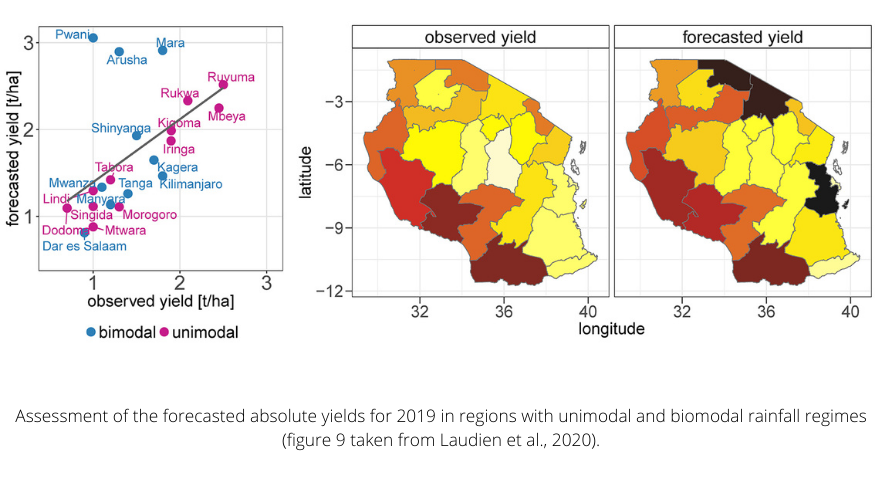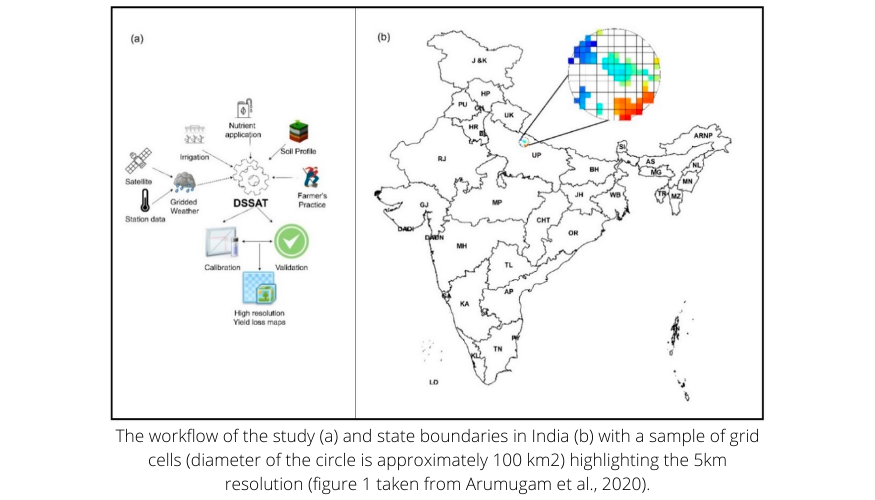Assessment of long-term cultivation risks as well as short-medium term yield prospects for agricultural crops to support the decision-making of agricultural and political stakeholders
Existing agricultural information systems will be supplemented by risk assessments on agricultural crops. These assessments will be co-developed in close cooperation with local postgraduate and experts through the implementation of short-term research projects and specific applications.
CROP YIELD FORECASTING AND INSURANCE SOLUTIONS
Within the EPICC project, it is proposed to supplement the existing agricultural information systems by agricultural crop risk assessments for changing climate conditions, extreme weather events. These assessments are developed and implemented in close cooperation with local, national and international experts and other stakeholders from the private and public sectors and civil society. Our work focuses on staple crops in Brazil, Ethiopia, Tanzania, India and Peru. EPICC aims to provide quantitative information of crop yields and crop failures incurred by weather events either in the immediate aftermath or even before the occurrence of such an event. The information might enable farmers – informed e.g. by ministries and farmers’ associations – to adjust their agronomic management practices in order to minimize the scope of weather-related crop losses and to increase their capacity to cope with climate risks. In particular, crop insurance schemes might be qualified using our results.
Therefore, the agricultural impact model AMPLIFY (Agricultural Model for Production Loss Identification to Insure Failures of Yields) as well as the Decision Support System for Agrotechnology Transfer (DSSAT) is be further developed and adopted to meet the needs of implementing insurance stakeholders. AMPLIFIY makes use of semi empirical measures and remote sensing satellite data to assess crop yields and crop losses. Through a seasonal forecasting system, this model provides information of crop yields and crop failures incurred by weather events either in the immediate aftermath or even before the occurrence of such an event. This can support the implementation of adaptation measures and increases farmer’s capacity to cope with climate change risks.
The focus of the agrometeorological information to be provided by EPICC has been adapted to the needs of the local stakeholders within the three target countries.
In Peru, EPICC provides information on weather-related risk for maize yield production in Peru based on statistical crop-models and machine learning approaches to support the development of Peru’s Nationally Determined Contributions (NDCs) and the implementation of suggested adaptation measures. While much of yield variability can be explained by weather indicators on a regional scale, this work highlights the spatial inhomogeneity of weather impact on yield. This in turn has implications on adaptation options like increasing the water availability, which has regionally different effects under future climate conditions. Details in:
- Laudien, R., Schauberger, B., Gleixner, S., Gornott, C. (2020). Assessment of weather-yield relations of starchy maize at different scales in Peru to support the NDC implementation. Agricultural and Forest Meteorology, 295, 108154. DOI: 10.1016/j.agrformet.2020.108154
In Tanzania, the year-to-year variability of crop yield is strong and dominated by weather impacts. EPICC quantifies this impact of weather on yields in Tanzania on sub-national level using the statistical crop-model AMPLIFY. This newly developed model can provide a forecast of maize yield about 6 weeks before harvest based on publicly available, global climate data only. Details in:
- Laudien, R., Schauberger, B., Makowski, D. and Gornott, C. (2020). Robustly forecasting maize yields in Tanzania based on climatic predictors. Scientific Reports, 10(1). DOI: 10.1038/s41598-020-76315-8

In India, the current government-backed PMFBY (Pradhan Mantri Fasal Bima Yojana) insurance scheme requires real-time information on yield losses in high spatial resolution and with high accuracy in order to trigger crop insurance payouts. In order to support these efforts, EPICC employed the process-based crop model DSSAT to provide rice yield and soil real-time information at 5km resolution based on weather and management information. A different approach employed machine learning techniques to provide real-time rice yield information at 500m resolution based on remote sensing data. Both efforts complement each other and can be used for yield loss assessments in India’s crop insurance scheme. Details in:
- Arumugam, P., Chemura, A., Schauberger, B. and Gornott, C. (2020). Near Real-Time Biophysical Rice (Oryza sativa L.) Yield Estimation to Support Crop Insurance Implementation in India. Agronomy, 10(11), p.1674. DOI: 10.3390/agronomy10111674
- Arumugam, P.; Chemura, A.; Schauberger, B.; Gornott, C. Remote sensing based yield estimation using gradient boosted regression on rice in India, to be submitted.

Related information
- Modeling For Agricultural Risk Management
Find a short video that explains the agricultural modeling of EPICC through the Agrati Project
- Conradt, T., Gornott, C. and Wechsung, F. (2016). Extending and improving regionalized winter wheat and silage maize yield regression models for Germany: Enhancing the predictive skill by panel definition through cluster analysis. Agricultural and Forest Meteorology, 216, pp.68-81. DOI: 10.1016/j.agrformet.2015.10.003
- Gornott, C. and Wechsung, F. (2015). Level normalized modeling approach of yield volatility for winter wheat and silage maize on different scales within Germany. Journal für Kulturpflanzen, (67) 6, 205–223. DOI: 10.5073/JFK.2015.06.01
- Gornott, C. and Wechsung, F. (2016). Statistical regression models for assessing climate impacts on crop yields: A validation study for winter wheat and silage maize in Germany. Agricultural and Forest Meteorology, (217) 89–100. DOI: 10.1016/j.agrformet.2015.10.005
- Schauberger, B., Gornott, C. and Wechsung, F. (2017). Global evaluation of a semiempirical model for yield anomalies and application to within-season yield forecasting. Global Change Biology, (23) 11, 4750–4764. DOI: 10.1111/gcb.13738
Contact person
Dr Stephanie Gleixner
Agricultural systems
stephanie.gleixner[at]pik-potsdam.de

Scientific advisors
|
Prof. Dr. Christoph Gornott
|
Dr. Bernhard Schauberger
|
|
Dr. Abel Chemura |
Prof. Dr. Hermann Lotze-Campen
|
Dr. Frank Wechsung
Agriculture
frank.wechsung[at]pik-potsdam.de











